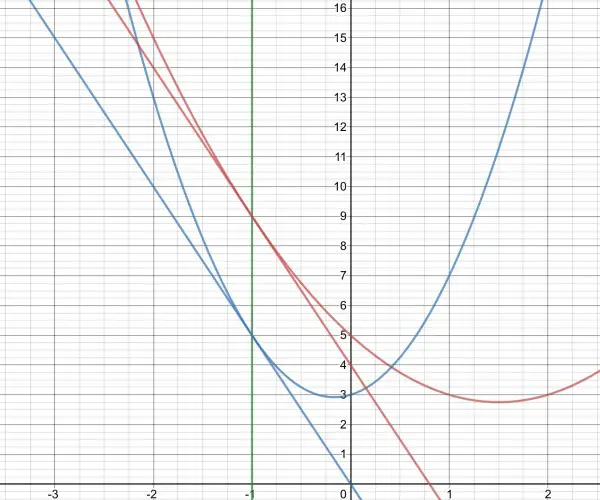The method I’ve used in this solution is best and most easily envisaged from a graphically viewpoint. Quadratics when graphed are parabolas. We use differentiation to find their gradients which for quadratics always produces linear expressions in x. When we equate the first derivative of each quadratic we get a unique value of x determining tangent points on each parabola and the unique parallel tangent lines, which will probably have a vertical and horizontal separation. If either or both of these separations are zero, then the parabolas will share one or two tangent lines. In part (a) we shall see that the vertices of the parabolas are almost aligned horizontally, while in part (b) the tangent lines on one of the left arms of the parabolas are close together. However (spoiler alert!), in neither case do they share a tangent line, as we shall see. The positioning of the parallel tangent lines tells us how far to shift one parabola left or right (horizontal displacement), up or down (vertical displacement) to meet the tangent line of the other. That takes us nicely to part (c) in which the conditions for tangent line sharing will be revealed.
This solution will take time and space to explain, and because of difficulties I experience on this website (because of long-standing system or network problems) I have to give the solution piecemeal through multiple editing. I hope you will be patient.
By considering the general case I hope to answer all parts of this question quickly.
Let f₁(x)=a₁x²+b₁x+k₁ and f₂(x)=a₂x²+b₂x+k₂, where a₁≠a₂. Differentiating:
f₁'(x)=2a₁x+b₁=f₂'(x)=2a₂x+b₂, and solving for x:
2(a₁-a₂)x=b₂-b₁, x=(b₂-b₁)/(2(a₁-a₂)).
Let t=(b₂-b₁)/(2(a₁-a₂)). There are two tangent points: (t,f₁(t)) and (t,f₂(t)), one on each parabola. Their vertical separation is |f₁(t)-f₂(t)|, because they have the same x coordinate (x=t).
Let g (gradient)=2a₁t+b₁=2a₂t+b₂=a₁(b₂-b₁)/(a₁-a₂)+b₁=(a₁b₂-a₂b₁)/(a₁-a₂).
The two gradient lines are: y=gx+c₁ and y=gx+c₂, where:
vertical separation=|c₁-c₂|=|f₁(t)-f₂(t)|, c₁ and c₂ are the y-intercepts.
The x-intercepts (x₁ and x₂) are found by setting y=0:
x₁=-c₁/g, x₂=-c₂/g, so horizontal separation is |x₁-x₂|=|(f₁(t)-f₂(t))/g|. So, if f₁(t)=f₂(t), there is no horizontal separation, and this is a condition that can be applied in part (c).
At this point, a picture should clarify the situation for part (a). The red curve is f₁ and the blue curve f₂. The red tangent line for f₁ is parallel to the blue tangent line for f₂. The green vertical line highlights the vertical displacement of the lines and the y-intercepts, and the x-intercepts can also be seen. The graph also shows that the vertices are not quite aligned, neither do the tangent points lie on a common tangent line. So you can see that there is no common tangent line for the part (a) scenario.

Imagine taking hold of the red line with parabola attached and pulling it horizontally leftwards until the red line sits on the blue line. The blue and red parabolas then share a tangent line. The amount of left shift is the difference between the x-intercepts ∆x=|x₁-x₂|. f₂(x+∆x) gives us a new quadratic based on f₂ but with x+∆x replacing x in the function. A right-shift (dragging the blue line on to the red line) would result in x-∆x substituting for x in f₁.
Now, imagine lifting up the red parabola so that its vertex aligns with (has the same y-coordinate or vertical height as) the blue parabola’s vertex. Both parabolas then have a common tangent at their vertices. To find out what needs to change to produce this upward displacement we need to calculate the position of the vertices of the two parabolas.
If we shift horizontally AND vertically we get two common tangent lines.
This graphical exercise gives us insight in determining if two parabolas share any tangent lines.
We need f₁ and f₂ in vertex form. At the vertices f₁'=0, f₂'=0, so x=-b₁/(2a₁), x=-b₂/(2a₂) respectively, and the vertices are (-b₁/(2a₁),k₁-b₁²/(4a₁)) and (-b₂/(2a₂),k₂-b₂²/(4a₂)), the y-coordinates of the vertices being f₁(-b₁/(2a₁)) and f₂(-b₂/(2a₂)).
The difference in vertical alignment is ∆y=|k₁-k₂+¼(a₁b₂²-a₂b₁²)/(a₁a₂)|.
When the vertices are vertically aligned, y=a₂(4a₁k₁-b₁²)=a₁(4a₂k₂-b₂²) which is the equation of the horizontal tangent line and a test for vertex alignment.
Now we have tests we can answer all parts of the question.
(a) a₁=1, b₁=-3, a₂=3, b₂=1, so t=(1-(-3))/(2(1-3))=4/(-4)=-1.
f₁(-1)=9, f₂(-1)=5, so f₁≠f₂ and there is no common tangent line on the arms of the parabolas. (Horizontal separation test.)
k₁=5, k₂=3 so the vertex alignment test is:
a₂(4a₁k₁-b₁²)=3(20-9)=33, a₁(4a₂k₂-b₂²)=36-1=35. 33≠35, so the vertices are not aligned. There are no common tangent lines.
(b) a₁=1, b₁=-3, a₂=b₂=2, k₁=1, k₂=9, so t=(2-(-3))/(2(1-2))=-5/2.
f₁(-5/2)=59/4, f₂(-5/2)=33/2. No common tangent line in the horizontal separation test.
Vertex separation test:
2(4-9)=-10, 72-4=68. No alignment.
(c) t=(b₂-b₁)/(2(a₁-a₂)); g=2a₁+b₁ or 2a₂+b₂.
Horizontal separation test:
f₁(t)=f₂(t) ⇒common tangent line: y=gx+f₁(t)-gt.
Vertex separation test:
a₂(4a₁k₁-b₁²)=a₁(4a₂k₂-b₂²), horizontal line:
y=a₂(4a₁k₁-b₁²) or a₁(4a₂k₂-b₂²).